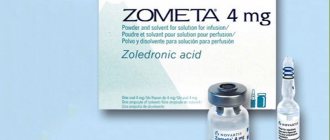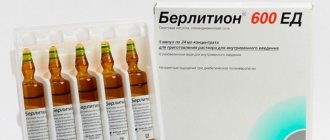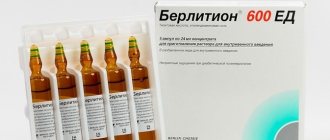Contraindications
- acute myocardial infarction;
- massive bleeding;
- cerebral hemorrhage;
- massive retinal hemorrhage;
- severe coronary or cerebral atherosclerosis;
- severe heart rhythm disturbances;
- childhood;
- hypersensitivity to pentoxifylline and similar drugs and substances from the group of xanthine derivatives, such as theophylline, caffeine, aminophylline or theobromine.
Should be used with caution in patients with heart failure and liver and kidney diseases.
Indications for use
- Peripheral circulation disorders occurring against the background of atherosclerotic, inflammatory and diabetic processes (including diabetic angiopathy, “intermittent” claudication caused by atherosclerosis, obliterating endarteritis);
- Ischemic cerebral circulatory disorders in chronic and acute (for concentrate) forms (including cerebral atherosclerosis);
- Disorders of tissue trophism associated with thrombosis of arteries or veins and microcirculation disorders: postthrombophlebitic syndrome, trophic ulcers, frostbite, gangrene;
- Angioneuropathy: acrocyanosis (for concentrate), paresthesia, Raynaud's disease;
- Conditions after ischemic or hemorrhagic stroke (for concentrate);
- Dyscirculatory and atherosclerotic encephalopathies (for tablets);
- Circulatory disorders in the vessels of the eye: acute, subacute (for tablets) and chronic circulatory failure in the choroid or retina;
- Disorders of the middle ear function of a vascular nature, accompanied by hearing loss.
Release form, composition and packaging
The solution for injection is clear, colorless or slightly yellowish.
| 1 ml | |
| pentoxifylline | 20 mg |
Excipients: sodium chloride, water for injection.
1 ml - ampoules (5) - polyethylene trays (1) - cardboard boxes.
The solution for injection is clear, colorless or slightly yellowish.
| 1 ml | 1 amp. | |
| pentoxifylline | 20 mg | 40 mg |
Excipients: sodium chloride, water for injection.
2 ml - ampoules (5) - polyethylene trays (1) - cardboard boxes.
The solution for injection is clear, colorless or slightly yellowish.
| 1 ml | 1 amp. | |
| pentoxifylline | 20 mg | 100 mg |
Excipients: sodium chloride, water for injection.
5 ml - ampoules (5) - polyethylene trays (1) - cardboard boxes.
Side effects
Nervous system: convulsive syndrome , anxiety, dizziness, headaches.
Skin: increased fragility of the nail plates, swelling, hyperemia of the skin, “flushes” to the skin of the face and body.
Digestive system: cholestatic hepatitis , exacerbation of cholecystitis , intestinal atony, decreased appetite, dry mouth.
Cardiac system: cardialgia , arrhythmia, tachycardia, drop in blood pressure, progression of angina .
Possible disturbance of visual perception, scotoma, thrombocytopenia, intestinal bleeding, allergic reactions, anaphylactic shock, increased activity of liver enzymes, alkaline phosphatase.
Drug interactions
Pentoxifylline may enhance the effect of other drugs that affect the blood coagulation system (indirect and direct anticoagulants, thrombolytics); enhances the effect on the coagulation system of drugs such as cefamandole, cefoperazone, cefotetan, moxalactam, plicamycin, valproic acid.
Pentoxifylline may enhance the effect of antihypertensive drugs, insulin, and oral hypoglycemic drugs.
Cimetidine increases the stable concentration of pentoxifylline in the blood plasma, and therefore an increase in the occurrence of side effects of the latter may be observed.
Co-administration with other drugs, representatives of this group, can increase the excitation of the central nervous system.
Pentoxifylline, solution for infusion 2 mg/ml
Chemical name: 3,7-dimethyl-1-(5-oxohexyl)-3,7-dihydro-1H-purine-2,6-dione General characteristics. The drug is a clear, colorless solution Composition of the drug 100 ml 250 ml 500 ml Active ingredients: Pentoxifylline 0.2 g 0.5 g 1.0 g Excipients: Sodium chloride 0.9 g 2.25 g 4.5 g Water for injections up to 100 ml up to 250 ml up to 500 ml Release form. Solution for infusion 2 mg/ml Pharmacotherapeutic group. Peripheral vasodilators. Purine derivatives. ATX code. CO4AD03 Pharmacological properties. Pharmacodynamics. Pentoxifylline is the main representative of the pharmacological group of drugs - hemorheological drugs. It increases the plasticity (deformability) of red blood cells, which allows them to penetrate into vessels with a changed lumen (diameter) and improve blood supply to tissues, especially against the background of hypoxia. It reduces their ability to aggregate, facilitates penetration into the extravascular bed, which also promotes tissue oxygenation. Pentoxifylline inhibits fibrinogen biosynthesis and reduces blood viscosity. Under the influence of the drug, the formation of pseudopodia in platelets is reduced. It is characteristic that with such a multifaceted intervention of pentoxifylline in the processes ensuring hemostasis, the risk of bleeding does not increase. During inflammation, pentoxifylline has the ability to reduce the adhesion and aggregation of polymorphonuclear leukocytes, inhibit the “metabolic explosion” and prevent their damaging effect on endothelial cells. It inhibits the activity of phosphodiesterase, inhibits the destruction of cAMP, reduces the concentration of intracellular calcium and enhances the effects of adenosine. 2 06/02/2014 Pentoxifylline has a mild vasodilator effect and prevents vascular contraction under the influence of vasoconstrictor stimuli. In recent years, it has been established that pentoxifylline has the ability to inhibit the production of proinflammatory cytokines (primarily tumor necrosis factor and interleukins-1,-2,-6). Pharmacokinetics. When administered intravenously, pentoxifylline enters the tissue and penetrates well through the blood-brain barrier. The half-life of pentoxifylline varies between 0.4 - 0.8 hours. It undergoes biotransformation in the liver with the formation of two main metabolites: 1-(5-hydroxyhexyl)-3,7-dimethylxanthine (metabolite-1) and 1-(3-carboxypropyl )-3,7-dimethylxanthine (metabolite-5), which have similar activity and have a half-life of 1 to 1.6 hours. 1.5 - 2 hours after infusion, the concentration of metabolites exceeds the content of the original compound by 5-8 times. By the 8th hour, the concentration of pentoxifylline and its metabolites in the blood decreases significantly (up to 10% of the initial value). Excreted mainly by the kidneys (up to 95%), mainly in the form of metabolite-5. Less than 4% of the drug is excreted in feces. In breastfeeding women it is secreted by the lactating glands. Due to the large volume of distribution and strong binding to erythrocytes, the pharmacokinetics of pentoxifylline during hemodialysis practically does not change. Indications for use Reduction of painful manifestations in cases of impaired peripheral circulation due to arteriopathy in combination with surgical treatment or in case of impossibility of surgical intervention. Method of administration and dosage The dose and method of administration are determined by the doctor depending on the severity of circulatory disorders and individual tolerance of the drug. The drug is administered intravenously 1-2 times a day, 200-300 mg (100-150 ml of solution containing 2 mg of pentoxifylline per ml). It is recommended to administer at a rate of no more than 100 mg/hour. In elderly people, it is advisable to reduce the dose and control blood pressure, especially when prescribed simultaneously with antihypertensive and vasodilating drugs. In patients with severe renal impairment, the dose should be reduced and adjusted according to individual tolerance. Side effects In cases where Pentoxifylline is used in large doses or at a high rate of infusion, the following side effects can sometimes occur: from the nervous system: headache, dizziness, anxiety, sleep disturbances, insomnia, convulsions; from the skin and subcutaneous fat: hyperemia of the facial skin, rushes of blood to the skin of the face and upper chest, swelling, increased brittleness of nails; from the digestive system: xerostomia, anorexia, intestinal atony, nausea, vomiting, abdominal pain, diarrhea; from the cardiovascular system: tachycardia, arrhythmia, cardialgia, progression of angina pectoris, decreased blood pressure; from the hemostasis system and hematopoietic organs: thrombocytopenia, bleeding from the vessels of the skin, mucous membranes, stomach, intestines; allergic reactions: itching, skin hyperemia, urticaria, angioedema, anaphylactic shock. Very rarely there are cases of development of aseptic meningitis, intrahepatic cholestasis and increased activity of “liver” transaminases. 3 06/02/2014 If side effects occur, you must stop taking the drug. If side effects occur that are not mentioned in the instructions, you must inform your doctor. Contraindications • increased sensitivity to pentoxifylline, other methylxanthines or any of the components of the drug; • massive bleeding; • extensive hemorrhages in the retina of the eye; • cerebral hemorrhage; • acute myocardial infarction; • severe arrhythmias; • severe atherosclerotic lesions of the coronary or cerebral arteries; • uncontrolled arterial hypotension; • age under 18 years; • pregnancy, lactation period. The drug should be used with caution in patients with: arterial hypotension (risk of low blood pressure), impaired renal function (creatinine clearance below 30 ml/min) (risk of accumulation and increased risk of side effects), severe liver dysfunction (risk of accumulation and increased risk of side effects), increased tendency to bleed, including as a result of the use of anticoagulants or disorders of the blood coagulation system (risk of more severe bleeding). Overdose Symptoms of overdose: weakness, sweating, nausea, cyanosis, dizziness, decreased blood pressure, tachycardia, fainting, drowsiness or agitation, arrhythmia, hyperthermia, areflexia, loss of consciousness, tonic-clonic convulsions, signs of gastrointestinal bleeding (vomiting like coffee grounds). Treatment is symptomatic: special attention should be paid to maintaining blood pressure and respiratory function. Convulsive seizures are controlled by administration of diazepam. When the first signs of overdose appear, immediately stop administering the drug. Provide a lower position of the head and upper body. Precautions Treatment should be carried out under blood pressure control. In patients with diabetes mellitus taking hypoglycemic agents, the administration of large doses can cause severe hypoglycemia (dose adjustment is required). When prescribing pentoxifylline simultaneously with anticoagulants, it is necessary to carefully monitor the indicators of the blood coagulation system. In patients who have recently undergone surgery, systematic monitoring of hemoglobin and hematocrit levels is necessary. The administered dose should be reduced in patients with low and unstable blood pressure. In elderly people, a dose reduction may be required (increasing bioavailability and reducing the rate of administration). The safety and effectiveness of pentoxifylline in children have not been sufficiently studied. Smoking may reduce the therapeutic effectiveness of the drug. Pregnancy and lactation. The safety of using pentoxifylline during pregnancy has not been established, and therefore prescribing the drug is not recommended. Pentoxifylline is excreted in breast milk, so breastfeeding should be discontinued during treatment. Interaction with other drugs Pentoxifylline can enhance the effect of drugs that lower blood pressure (ACE inhibitors, nitrates). Pentoxifylline may enhance the effect of drugs that affect the blood coagulation system (indirect and direct anticoagulants, thrombolytics), antibiotics (including cephalosporins). Cimetidine increases the plasma concentration of pentoxifylline (risk of side effects). Coadministration with other xanthines may lead to excessive nervous stimulation. The hypoglycemic effect of insulin or oral antidiabetic agents may be enhanced when taking pentoxifylline (increased risk of hypoglycemia). Strict monitoring of such patients is necessary. In some patients, concomitant use of pentoxifylline and theophylline may lead to an increase in theophylline levels. This may result in more or worse theophylline-related side effects. Storage conditions. In a place protected from light at a temperature not exceeding 25 °C. Keep out of the reach of children. Best before date. 2 years. Do not use after expiration date. Vacation conditions. By doctor's prescription. Package. 100 ml, 250 ml and 500 ml in polymer containers for infusion solutions. Each polymer container, along with instructions for medical use, is placed in a transparent bag. For hospitals: each polymer container is placed in a transparent bag and placed together with instructions for medical use in quantities corresponding to the number of polymer containers, in corrugated cardboard boxes 100 ml, 80 or 100 packages, 250 ml, 40 or 55 packages, 500 ml 25 or 30 packs. Information about the manufacturer Belarusian-Dutch joint venture limited liability company "Farmland", Republic of Belarus 222603, Minsk region, Nesvizh, st. Leninskaya, 124-3 Tel./fax 8(017)2624994, tel. 8(01770)63939
special instructions
The compatibility of the pentoxifylline solution with the infusion solution should be checked on a case-by-case basis.
When performing IV infusions, the patient should be in a supine position.
The drug is well tolerated by patients at the recommended infusion rate and by injection.
When administering the drug intravenously and intravenously, care must be taken.
The dose of the drug should be reduced for patients with low and unstable blood pressure.
In older people, the elimination of the drug is reduced, and therefore a reduction in the dose of the drug may be necessary.
The safety and effectiveness of pentoxifylline in children have not been studied.
Smoking may reduce the therapeutic effectiveness of the drug.
Overdose
Taking increased doses of the drug Pentoxifylline causes a drop in blood pressure, dizziness, tachycardia, fainting, hyperthermia, agitation, tonic-clonic convulsions , areflexia, vomiting “coffee grounds” and other signs of bleeding from the digestive tract. Timely rinsing of the digestive system, taking enterosorbents, and symptomatic therapy are required. If bleeding develops, emergency measures are taken to stop the bleeding.







